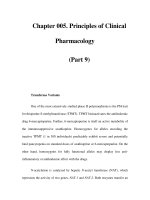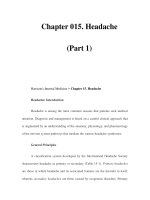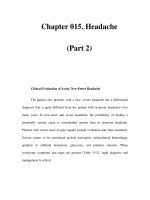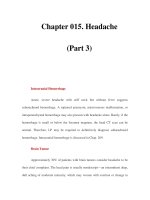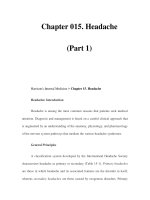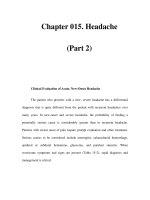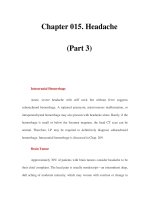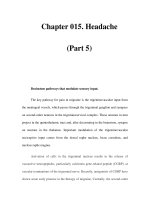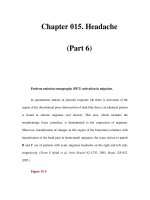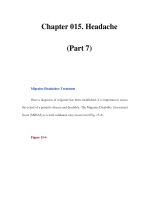Chapter 015. Headache (Part 9) pps
Bạn đang xem bản rút gọn của tài liệu. Xem và tải ngay bản đầy đủ của tài liệu tại đây (16.84 KB, 5 trang )
Chapter 015. Headache
(Part 9)
Abbreviations: NSAIDs, nonsteroidal anti-inflammatory drugs; 5-HT, 5-
hydroxytryptamine.
In general, an adequate dose of whichever agent is chosen should be used
as soon as possible after the onset of an attack. If additional medication is required
within 60 min because symptoms return or have not abated, the initial dose should
be increased for subsequent attacks. Migraine therapy must be individualized; a
standard approach for all patients is not possible. A therapeutic regimen may need
to be constantly refined until one is identified that provides the patient with rapid,
complete, and consistent relief with minimal side effects (Table 15-6).
Table 15-6 Clinical Stratification of Acute Specific Migraine
Treatments
Clinical Situation Treatment Options
Failed NSAIDS/analgesics
First tier
Sumatriptan 50 mg or 100 mg PO
Almotriptan 12.5 mg PO
Rizatriptan 10 mg PO
Eletriptan 40 mg PO
Zolmitriptan 2.5 mg PO
Slower effect/better tolerability
Naratriptan 2.5 mg PO
Frovatriptan 2.5 mg PO
Infrequent headache
Ergotamine 1–2 mg PO
Dihydroergotamine nasal spray 2
mg
Early nausea or difficulties
taking tablets
Zolmitriptan 5 mg nasal spray
Sumatriptan 20 mg nasal spray
Rizatriptan 10 mg MLT wafer
Headache recurrence
Ergotamine 2 mg (most effective
PR/usually with caffeine)
Naratriptan 2.5 mg PO
Almotriptan 12.5 mg PO
Eletriptan 40 mg
Tolerating acute treatments
poorly
Naratriptan 2.5 mg
Almotriptan 12.5 mg
Early vomiting Zolmitriptan 5 mg nasal spray
Sumatriptan 25 mg PR
Sumatriptan 6 mg SC
Menses-related headache
Prevention
Ergotamine PO at night
Estrogen patches
Treatment
Triptans
Dihydroergotamine nasal spray
Very rapidly developing
symptoms
Zolmitriptan 5 mg nasal spray
Sumatriptan 6 mg SC
Dihydroergotamine 1 mg IM
